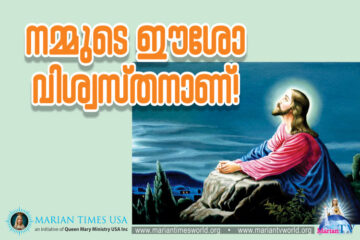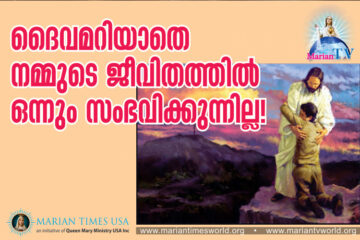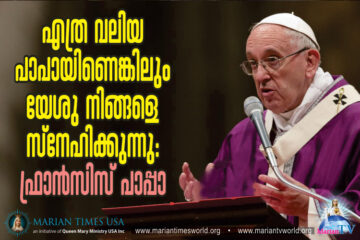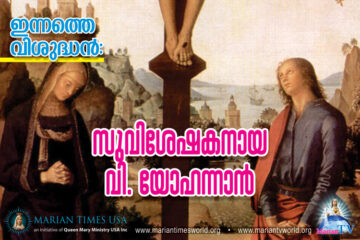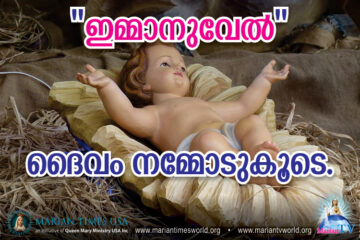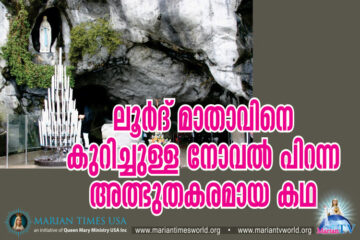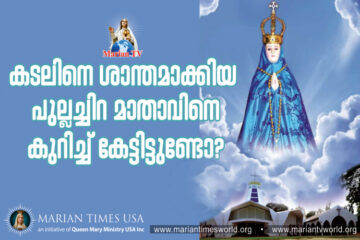THE MYSTERY OF THE MOST HOLY TRINITY
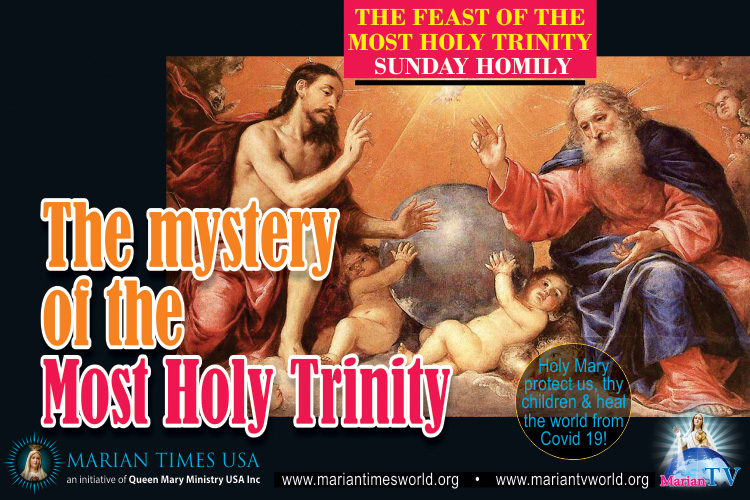
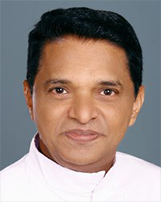
~ Fr. Abraham Mutholath ~
Chicago, USA. ~
SUNDAY HOMILY THE FEAST OF THE MOST HOLY TRINITY
INTRODUCTION
Many Catholic believers give importance to the feast of saints because most of our churches and institutions are under the patronage of saints. However, the prominent feast in the church is that of God who is the source of all blessings. Saints are models of our faith and charity and we ask their intercessory prayers for us. They are venerated as Christian heroes and we do not worship them. All our worship, including our devotion to the saints are directed to the only one God with three persons. All the three persons of the one God – the Father, the Son, and the Holy Spirit – are with us who are baptized in the Trinitarian formula. Let us worship the Most Holy Trinity with a better understanding based on the profession of faith of the Catholic church as given in the Nicene Creed.
The Nicene Creed
I believe in one God,the Father almighty,maker of heaven and earth,of all things visible and invisible.
I believe in one Lord Jesus Christ,the Only Begotten Son of God,born of the Father before all ages.God from God, Light from Light,true God from true God,begotten, not made, consubstantial with the Father;through him all things were made.For us men and for our salvation he came down from heaven,and by the Holy Spirit was incarnate of the Virgin Mary,and became man.For our sake he was crucified under Pontius Pilate,he suffered death and was buried,and rose again on the third dayin accordance with the Scriptures.He ascended into heaven and is seated at the right hand of the Father.He will come again in gloryto judge the living and the dead and his kingdom will have no end.
I believe in the Holy Spirit, the Lord, the giver of life,who proceeds from the Father and the Son,
who with the Father and the Son is adored and glorified,who has spoken through the prophets.
I believe in one, holy, catholic and apostolic Church.I confess one Baptism for the forgiveness of sinsand I look forward to the resurrection of the deadand the life of the world to come. Amen.
Interpretation
We are baptized using the Trinitarian formula. This is based on Jesus’ command to his disciples stating: “Therefore, go and make disciples of all the nations, baptizing them in the name of the Father and the Son and the Holy Spirit.” (Mathew 28:20). We start our prayers “in the name of the Father, the Son, and the Holy Spirit.” We conclude our prayers saying, “The Father, the Son, and the Holy Spirit, the Lord of all, forever.” The blessing in our liturgy is taken from 2 Corinthians 13:14. “May the grace of the Lord Jesus Christ, and the love of God, and the fellowship of the Holy Spirit be with you all.” Thus, we bless ourselves or others bless us in the name of the Most Holy Trinity. On this feast of the Most Holy Trinity, it is good to reflect on the Most Holy Trinity based on the Nicene Creed that we recite as part of many of our prayers especially Holy Mass.
Faith in God(I believe in one God)
A full understanding of one God in three persons is a mystery that is difficult to comprehend with our human limitations. Several attempts have been made by theologians and teachers to illustrate this mystery understandable to people using metaphors,resemblance materials and artforms. However, none of them is adequate because there is nothing in this world that has a corresponding existence. A child has limited knowledge and capacity to understand. So, the child trusts the parents, believes what they say, and follows what they tell to do. As children of God, we who have limited comprehension trust God and follow the teachings of Jesus. Heresies happened based on different interpretations and disputes on this topic among Christian scholars. For a believer, faith in the Most Holy Trinity is an article of faith and not a topic for dispute.
Oneness of the Trinity(I believe in one God)
We first express our faith in the oneness of God. Israelites lived among the pagans who worshipped the forces of nature and created beings as gods.The Almighty God commanded through Moses: “You shall not have other gods beside me. You shall not make for yourself an idol or a likeness of anything in the heavens above or on the earth below or in the waters beneath the earth; you shall not bow down before them or serve them.” (Exodus 20:3-5a). Jesus affirmed this oneness of God along with his revelation of the three persons in the Most Holy Trinity. Jesus commanded his disciples to use the Trinitarian formula for baptism. Though three persons of the Holy Trinity are recited, it should start with the singular word “In the name” (not “names”) of the Father, the Son, and the Holy Spirit (Mark 12:29-30).
This faith in one and true God is based on a loving relationship with our creator, sustainer and redeemer. “Hear, O Israel: the LORD our God is one LORD; and you shall love the LORD your God with all your heart, and with all your soul, and with all your might.” (Deut. 6:4,5). Love is a two-way relation and commitment. God who made covenant with Israel compared his relationship with them as a father’s love for his son, stronger than a mother’s love for her children, and more than a bridegroom’s love for his beloved. It is out of this love that he gave His only begotten son for our redemption (John 3:16). Hence, John concludes that “God is love” (1 John 4:8) and the three persons of the Most Holy Trinity are united in love. We are called to be in a loving communion with God and with one another who are also dear children of God.
God the Father(I believe in one God, the Father)
Since God the Father is the first and hierarchically top divine person of the Most Holy Trinity, we reflect and acknowledge what God the Father has done and is doing for us. In the Old Testament, God is Father because he is our creator. “Is he not your Father, your Creator, who made you and formed you?” (Deuteronomy 32:6). Similarly, Malachi 2:10 asks: “Do we not all have one Father? Did not one God create us?” The Israelites who had covenant relationship with God, considered God as their father and themselves as the first-born children of God. Quoting God, Moses told Pharaoh of Egypt: “Israel is my firstborn son.” (Exodus 4:22). Other people are also children of God. However, first born had some special privileges. They inherited a double portion and were considered holy.
Since God is called Father, it is indicative of a loving relationship between God and humanity like a parent and children. Since God is beyond sexual distinction, God’s parental tenderness is also expressed in the image of motherhood. Through Isaiah God said, “As a mother comforts her child, so I will comfort you.” (Isiah 66:13).
God theAlmighty(I believe in one God, the Father almighty)
Our heavenly Father is omnipotent because He who created everything in this universe has power and control on everything and he can do anything He wishes. This universal power of God is expressed in different parts of the Bible. For example: “You alone are the LORD. You made the heavens, even the highest heavens, and all their starry host, the earth and all that is on it, the seas and all that is in them. You give life to everything, and the multitudes of heaven worship you.” (Nehemiah 9:6).
God the Creator (Maker of heaven and earth)
God the Father is creator of heaven and earth and everything in it.That doesn’t mean that only God the Father was at work. The Son and the Holy Spirit were also involved in the creation. The participation of the three persons in one God is evident in the creation account of man. God said: “Let US make man in OUR image, after OUR likeness.” (Genesis 1:26). This verse says that God is more than one person, while remaining one God. St. Paul writes about the involvement of Jesus in the creation: “For by Him all things were created, both in the heavens and on earth, visible and invisible, whether thrones or dominions or rulers or authorities– all things have been created through Him and for Him. He is before all things, and in Him all things hold together.” (Colossians 1:15-17). St. John also writes about the role of Jesus in creation: “God created everything through him, and nothing was created except through him.” (John 1:3). The Holy Spirit was involved in the creation is evident from Genesis 1:2 “The earth was formless and void, and darkness was over the surface of the deep, and the Spirit of God was moving over the surface of the waters.” Psalm 104:30 is as follows: “When you send forth your Spirit, they are created, and you renew the face of the ground.” Thus, unified work of the three persons of the Trinity is seen in the creation.
Maker of heaven and earth, of all things visible and invisible.
“Heaven and earth” means all that exists that are known and unknown to us. Heavens designate not just the sun, moon, and stars but the humanly invisible bodies of the universe and the upper heavens where saints, angels, and God dwell. The creation of earth also includes humans, the culmination of God’s creation in the image and likeness of God. God created all of them in six days so that the seventh day be kept holy.
I believe in one Lord Jesus Christ,
The word for “Jesus” in Hebrew is Joshua which means “God saves.” This name is suitable for Jesus, the God who came to save us. Jesus was also called Messiah in Hebrew and Christ in Greek which means anointed. The anointed people in Israel were kings, prophets, and priests. Christ held all these positions together and accomplished his mission that his Father entrusted him. God the Father anointed Jesus through the Holy Spirit when John the Baptist baptized Jesus at river Jordan. That was why, on the day of Pentecost, Peter preached, “God anointed Jesus of Nazareth with the Holy Spirit and power.” (Acts 10:38). The baptizer heard Father’s voice declaring, “This is my beloved Son, with whom I am well pleased.” (Mathew 3:17). The Holy Spirit anointed Jesus at that time appearing in the form of a dove. Thus, the Most Holy Trinity manifested to John at the start of the public ministry of Jesus.
Kyrios (the Lord) was the Greek word used for the name of God. YHWH himself had revealed this to Moses. The title “Lord” indicates the sovereignty of God. The same term “Lord” was used for Jesus in the New Testament acknowledginghis divinity. St. Thomas addressed Jesus, “My Lord, my God” (John 20:28) affirming the divinity of Jesus.
The Only Begotten Son of God,
In the Old Testament, “son of God” was attributed to the angels, the kings, the chosen ones, and the children of Israel(CCC #441). They are creations of God and not sons in the strict sense. However, Jesus is the eternally begotten Son of God. Meaning of begotten is fathered or generated by procreation. So, Jesus as the begotten son of God means he is also God. No one else can claim this position.
Born of the Father before all ages.
Jesus was with the Father from all eternity. When we use the term born, it must not be taken in the worldly sense of giving birth though there is a father-son relationship between the two persons of the Most Holy Trinity. “In the beginning was the Word, and the Word was with God, and the Word was God. He was with God in the beginning.” (John 1:1-2).
God from God, Light from Light, true God from true God
Jesus said, “I came from the Father and entered the world; now I am leaving the world and going back to the Father.” (John 16:28). “Whoever sees Me sees the One who sent Me.” (John 12:45). Hence, Jesus is God who came from God the Father.
God is the source of all light. Light was there even before the creation of the sun, moon, and stars that were formed only on the fourth day. Jesus who proceeds from the Father said, “I am the light of the world. Whoever follows me will never walk in darkness, but will have the light of life.” (John 8:12).
Jesus said of his Father: “He who sent me is true, and I declare to the world what I have heard from him.” (John 8:26). So, what Jesus taught is the truth. Jesus affirmed of himself saying: “I am the way and the truth and the life. No one comes to the Father except through me.” (John 14:6). Thus, Jesus and his Father are true and conveyed the truth to us.
Begotten, not made
Though Jesus had a human birth in Bethlehem from Mary, he was eternally begotten from His Father in heaven. To beget and to create have different meanings. Humans beget human babies and what they produce different from them is called their creation. So, God the Father beget Jesus who in essence is God. Thus, Jesus is Son of God in its full sense. Man, especially Adam, is a creation of God in his image and likeness. So, “son of God” when used for humans, shows their intimate relationship with God but not equivalent to Jesus, the Son of God.
Consubstantial with the Father
The Son is “consubstantial with the Father” means “in the Father and with the Father the Son is one and the same God.” (Catechism of the Catholic Church. #262).The reason is that unlike other “sons of God” who are created by God, Jesus is the eternally begotten son of God. Thus, Jesus and the Father are substantially one.
Through him all things were made
John wrote of Jesus: “Through him all things were made; without him nothing was made that has been made.” (John 1:3). St. Paul wrote: “For in him all things were created: things in heaven and on earth, visible and invisible, whether thrones or powers or rulers or authorities; all things have been created through him and for him.” (Colossians 1:16).
For us men and for our salvation he came down from heaven
The redemptive ministry of Jesus is associated with the fall of the first parents and the propagation of sin to all succeeding generations. God promised a redeemer, the second person of the Trinity, before expelling Adam and Eve from the paradise. That was fulfilled in the incarnation and redemptive ministry of Jesus.
And by the Holy Spirit was incarnate of the Virgin Mary, and became man.
In the fullness of time, God sent Angel Gabriel to the Blessed Virgin Mary for her consent to be the mother of His Son. The angel revealed to her, “The Holy Spirit will come on you, and the power of the Most High will overshadow you. So the holy one to be born will be called the Son of God.” (Luke 1:35). God through Angel Gabriel asked Joseph to “take Mary as your wife, for that which is conceived in her is of the Holy Spirit” (Mathew 1:20). The Father worked through the Holy Spirit for the miraculous virgin conception of the Son of God in Mary. The birth of Jesus was also as a human being in its fullness except sin.
For our sake
Jesus came as the sacrificial Lamb of God. Israelites killed one lamb per family in Egypt to save the first-born child. Jesus is the perfect lamb that came from God to sacrifice himself so that our lives could be saved. He was the perfect and final scapegoat selected to die for the sins of the people (Lev. 16: 7-10). John the Baptist testified Jesus to the public saying: “Behold, the Lamb of God, who takes away the sin of the world!” (John 1:29). Jesus spoke of himself: “For even the Son of Man came not to be served but to serve others and to give his life as a ransom for many.” (Mathew 20:28).
He was crucified under Pontius Pilate, he suffered death and was buried, and rose again on the third day
Christ’s suffering, death, burial and resurrection was a predesigned salvific plan of God with a purpose to redeem mankind. St. Peter told the Jewish leaders in his speech on the Day of Pentecost: “But God knew what would happen, and his prearranged plan was carried out when Jesus was betrayed. With the help of lawless Gentiles, you nailed him to a cross and killed him.” (Acts 2:23). God sent Jesus and Jesus came willingly to the world to be with the people, to reveal God’s love for them and to offer the perfect sacrifice of himself as the paschal lamb for the forgiveness of sins. According to St. Paul, Jesus “is the beginning and the firstborn from among the dead.” (Colossians 1: 18). His resurrection has guaranteed the resurrection of his followers. The passion, death and resurrection of Jesus, followed by the descent of the Holy Spirit on the day of Pentecost, gave the disciples of Jesus a new model for gaining victory by carrying the cross of suffering and martyrdom for the church.
In accordance with the Scriptures.
The mission of Jesus and his victory through suffering was foretold in the Bible. “He was oppressed and treated harshly, yet he never said a word. He was led like a lamb to the slaughter. And as a sheep is silent before the shearers, he did not open his mouth.” (Isaiah 53:7). Jesus himself confirmed that his sufferings were for the fulfillment of the scriptures. After his resurrection, Jesus told the two disciples who were going from Jerusalem to Emmaus: “’Oh, how foolish you are! How slow of heart to believe all that the prophets spoke! Was it not necessary that the Messiah should suffer these things and enter into his glory?’ Then beginning with Moses and all the prophets, he interpreted to them what referred to him in all the scriptures.” (Luke 24:25-27).
He ascended into heaven
Jesus, the second person of the Most Holy Trinity ascended into heaven with his resurrected and glorified body. He returned to where he came from, his Father’s house. He went there to prepare places for those who are his followers (John 14:2). We believe in the promise of Jesus: “I, when I am lifted up from the earth, will draw all people to myself.” (John 12:32).
Jesus is seated at the right hand of the Father.
After his ascension, Jesus was seated at the right hand of his Father. “Sitting at the right hand” shows the high position Jesus has in heaven. The one who sits at the right hand of the supreme head is the second in command like a prime minister, or queen. Jesus oversees everything and it is only through him we reach the Father. Thus, the Messianic Kingdom, as envisioned by Daniel was inaugurated by the ascension of Jesus to heaven. “He was given authority, glory and sovereign power; all nations and peoples of every language worshiped him.” (Daniel 7:14).
He will come again in glory
Jesus assured his disciples: “I will come back and take you to be with me that you also may be where I am.” (John 14:3). He spoke of the glorious return to reestablish the kingdom in its fullness: “When the Son of Man comes in His glory, and all the angels with Him, He will sit on His glorious throne. All the nations will be gathered before Him, and He will separate the people one from another, as a shepherd separates the sheep from the goats.” (Mathew 25:31-32).
To judge the living and the dead
The Father has entrusted the judgement of the world to his Son (John 5:22). This judgement will be based on one’s own choice of belief in Jesus or not. “Whoever believes in him is not condemned, but whoever does not believe is condemned already, because he has not believed in the name of the only Son of God.” (John 3:18). The final judgement is to separate the good from the evil who have been growing together (Mathew 25:31-46).
His kingdom will have no end.
In the Davidic covenant, God promised David a heir from him whose kingdom will be everlasting (2 Samuel 7:13-16). According to Daniel, “His dominion is an everlasting dominion that will not pass away, and his kingdom is one that will never be destroyed.” (Daniel 7:14). St. Peter wrote: “Then God will give you a grand entrance into the eternal Kingdom of our Lord and Savior Jesus Christ” (2 Peter 1:11). According to the vision of John in the book of Revelation: “The seventh angel sounded his trumpet, and there were loud voices in heaven, which said: ‘The kingdom of the world has become the kingdom of our Lord and of his Messiah, and he will reign for ever and ever.’” (Rev. 11:15).
I believe in the Holy Spirit
Since the Holy Spirit proceeds from the Father and the Son, the Spirit is also God and is in communion with the other two persons of the Most Holy Trinity. The Holy Spirit was in existence from eternity and is mentioned in the Bible from the time of creation. The Holy Spirit has been at work from the time of incarnation of Jesus, at the beginning of the public ministry of Jesus at River Jordan, and at the beginning of the church on the day of Pentecost. Jesus started his public ministry quoting from Isaiah the prophet, “The Spirit of the Lord is on me, because he has anointed me to proclaim good news to the poor.” (Luke 4:18, Isaiah 61:1). The Holy Spirit that came on the apostles continues guiding the church.
The Lord, the giver of life,
The Holy Spirit is the source of physical and spiritual life. Following are a few of the examples: The “Spirit of God was hovering over the surface of the waters” (Genesis 1:2) at the time of creation. “Then the LORD God formed a man from the dust of the ground and breathed into his nostrils the breath of life, and the man became a living being.” (Genesis 2:7). The Holy Spirit came upon Mary for the incarnation of Jesus (Mathew 1:18). Jesus had promised: “Rivers of living water will flow from within him.” (John 7:38). John continues: “He said this in reference to the Spirit that those who came to believe in him were to receive. There was, of course, no Spirit yet, because Jesus had not yet been glorified.” (John 7:39). After his glorification, this life-giving Holy Spirit came on the apostles inaugurating the formation of the church. (Acts 2:1-13).
Who proceeds from the Father and the Son who with the Father and the Son is adored and glorified, who has spoken through the prophets.
As the Father eternally begets the Son, the Holy Spirit proceeds eternally from the Father and the Son. We adore and glorify all the three persons of the Most Holy Trinity when we adore and glorify any of the persons of the Holy Trinity. The works of the Holy Spirit was also mentioned by several prophets of the Old Testament.
Conclusion
Though we speak distinct of the Father, the Son and the Holy Spirit, they cannot be separated. Whoever sees Jesus, sees the Father and whoever receives the Holy Spirit receives the Father and the Son. The Most Holy Trinity is represented on the altar in the sanctuary of the church. The altar itself is the throne of God. In the Syro-Malabar churches, Gospel is placed on the right side of the altar representing Jesus the Word of God who sits at the right hand side of his Father. St. Thomas Cross with dove on the top representing the presence of the Holy Spirit is placed on the left side of the altar. Same representation of the Most Holy Trinity was in the Sanctuary of the Holy Temple in Jerusalem where the Ark of the Covenant represented the Seat of God the Father, the 12 show bread (Bread of the Presence) represented Jesus in the Holy Eucharist, and the menorah with 7 flames represented the Holy Spirit that came on the Apostles on the Day of Pentecost. These were hidden truths of the New Testament in the Old as St. Augustine said: “New Testament lies hidden in the Old and the Old Testament is unveiled in the New.”
Message
- Our primary importance in the Christian devotion shall be to the Lord Almighty, who is three persons in one God. This should be emphasized to our children because they might be misunderstood by the solemn celebration of the feasts of saints and other devotions to the saints.
- When we ignore God, or rely solely on material possessions,we are breaking the first of the 10 commandments of God. God is to be sought in our good times and bad times.
- We have to train our children to acknowledge that we are created by God and it is God who protects us and provides all our necessities in life.
- The love of God is to be expressed in loving God’s children, especially those who need our support spiritually, morally,or financially.
- The unity of the Most Holy Trinity is based onan unbreakable bond of love. It is a model for a Christian family where father, mother, and children must beunited in love.
- The persons of the Most Holy Trinity are inseparable.So, let us be mindful that when we receive the Holy Eucharist at the Holy Mass, all persons of the Holy Trinity are coming to us. Let us be conscious of the presence of the Most Holy Trinity at the altar of our churches and in the reception of the sacraments.
മരിയന് ടൈംസിലെ ഇന്നത്തെ പ്രധാനപ്പെട്ട അപ്ഡേറ്റുകള് താഴെ ലഭിക്കുന്നതാണ്.


